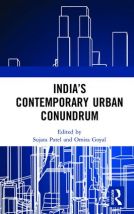India’s Contemporary Urban Conundrum

“India is in the process of a revolutionary urban transition” (page 1). India’s Contemporary Urban Conundrum reflects on the process of urbanization in India from a broad range of disciplinary perspectives, including geography, economics, political science, sociology, architecture, environmental science, filmmaking and grassroots activism, among others. It investigates the variety and complexity of the dimensions of urbanization and how these impact people’s lives, highlighting “the paradoxes and contradictions that organise India’s urban conundrum” (page 14).
The volume is organized according to five thematic areas:
1) The debate on defining the urban
2) The conditions generating work, living and (in)security
3) The nature of contemporary cities
4) The dilemmas organizing urban policy, planning and governance
5) The issues concerning ecology, environment and wellbeing
In Part 1, the contributions recognize the difficulty in delineating the urban and non-urban. Two main hypotheses are considered: “rurbanization” proposes that settlements retain a rural socioeconomic base but have urban characteristics, while “subaltern urbanization” proposes that a city is a system of interrelationships and is relatively autonomous and independent of the metropolis.
In Part 2, the chapters grapple with inequalities, exclusion, segregation and vulnerability. The question of access is central, including in terms of access to services, work opportunities, transport and public spaces, and how access is differentiated according to socioeconomic status and gender.
Contributions to Part 3 highlight the attributes of contemporary Indian cities. These include the use of real estate and the private sector in urban development, the digitization of service delivery, and the privatization of municipal governance.
In Part 4, the contributions examine different aspects of India’s urban policy framework to highlight the general incoherence between policy and reality.
Finally, Part 5 deals with the environmental and ecological dimensions of urbanization. Some of the contributions in this section consider the role of cities as ecosystems that have environmental functions, and the impact of environmental degradation in cities and by cities on human and non-human wellbeing. The chapters within Part 5 illuminate the relationship between the environment and urbanization in India, discussing key environmental challenges related to urbanism.
The chapter entitled “Nurturing urban commons for sustainable urbanisation” focuses on the peri-urban interface as an urban commons, and the implications of urbanization trends on peri-urban land and the ecosystem services and natural resources this land provides. The chapter examines land-use change in the urban commons in rapidly urbanizing Bengaluru, demonstrating the negative social impacts on local and migrant users in terms of their livelihoods and subsistence. It argues that the urban commons in the peri-urban interface must be “recognised as interconnected social and ecological systems serving multiple functions, and not merely as readily available land for further infrastructural development” (page 261).
The chapter entitled “The unsustainable urban waste economy” outlines issues pertaining to waste generation and management in India. In particular, it focuses on issues of poverty, discrimination and governance in relation to the waste system. It emphasizes the importance of the informal waste economy in absorbing and mitigating the negative costs of waste. Moreover, the chapter highlights the intersecting forms of oppression and discrimination that informal waste workers face, including along the lines of socioeconomic status, education, caste, tribe, gender, and stigma associated with waste work. This discrimination is exacerbated by poor governance and “widespread official ignorance of [the informal waste economy’s] character and significance” (page 276). The chapter argues for the need for acts of resistance and empowerment that focus on the specific problems of waste work and waste generation.
More information available at:
https://www.routledge.com/Indias-Contemporary-Urban-Conundrum-1st-Editio...
Book note prepared by Kate Goh
Search the Book notes database
Our Book notes database contains details and summaries of all the publications included in Book notes since 1993 - with details on how to obtain/download.
Use the search form above, or visit the Book notes landing page for more options and latest content.
For a searchable database for papers in Environment and Urbanization, go to http://eau.sagepub.com/

